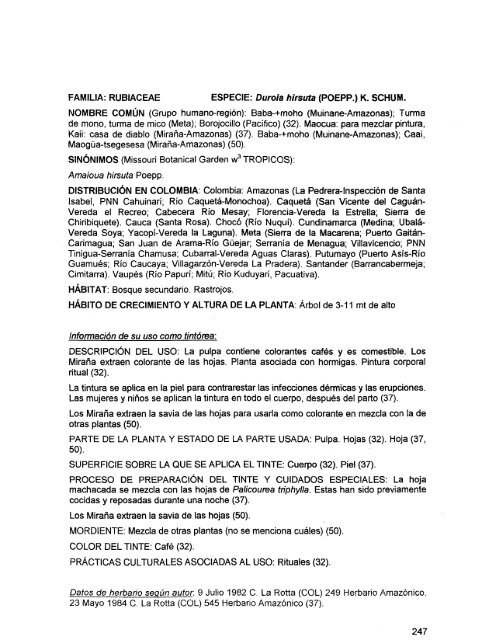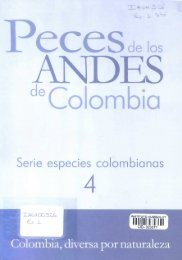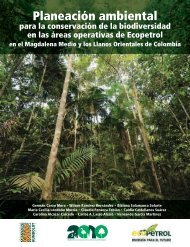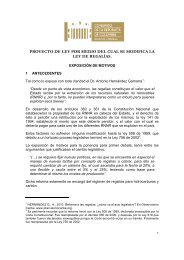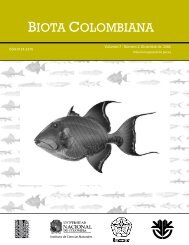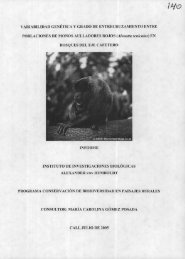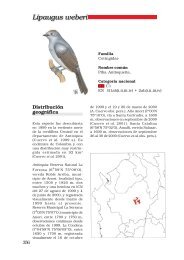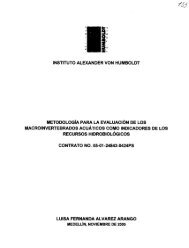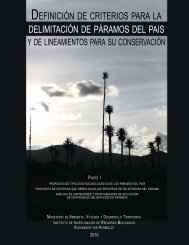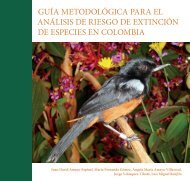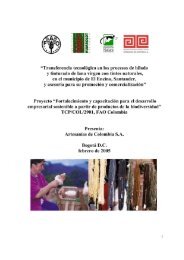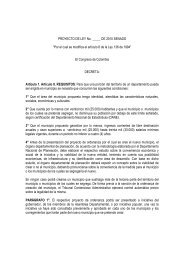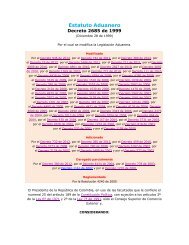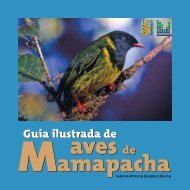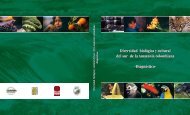- Page 1 and 2:
INFORME FINAL SISTEMATIZACiÓN DE A
- Page 3 and 4:
INTRODUCCiÓN A partir del trabajo
- Page 5 and 6:
1. PLANTILLA PARA ESPECIES DE USO L
- Page 7 and 8:
"'PARTE DE LA PLANTA Y ESTADO DE LA
- Page 9 and 10:
Gumilla hablando de los indios del
- Page 11 and 12:
3. DOCUMENTO DE ESPECIES DE USO Par
- Page 13 and 14:
ESPECIE: Conocarpus erecta L. (seg
- Page 15 and 16:
[Palicourea sp>http://www.siac.net.
- Page 17 and 18:
Biblioteca: Instituto de Ciencias N
- Page 19 and 20:
Se aconseia antes de seguir incluye
- Page 21 and 22:
1. DOCUMENTO ESPECIES DE USO ANEXOS
- Page 23 and 24:
FAMILIA: DENNSTAEDTIACEAE ESPECIE:
- Page 25 and 26:
FAMILIA: ARACEAE ESPECIE: Dieffenba
- Page 27 and 28:
FAMILIA: ARACEAE ESPECIE: PhiJodend
- Page 29 and 30:
ALTITUD I RANGO AL TITUDINAL: Desde
- Page 31 and 32:
FAMILIA: ARECACEAE ESPECIE: Euterpe
- Page 33 and 34:
FAMILIA: ARECACEAE ESPECIE: Geonoma
- Page 35 and 36:
FAMILIA: HELlCONIACEAE ESPECIE: Hel
- Page 37 and 38:
FAMILIA: IRIDACEAE ESPECIE: Crocus
- Page 39 and 40:
FAMILIA: L1L1ACEAE ESPECIE: Dianell
- Page 41 and 42:
FAMILIA: MARANTACEAE ESPECIE: Calat
- Page 43 and 44:
FAMILIA: POACEAE ESPECIE: Zea mays
- Page 45 and 46:
FAMILIA: STRELlTZIACEAE ESPECIE: Ph
- Page 47 and 48:
DISTRIBUCiÓN EN COLOMBIA: Especie
- Page 49 and 50:
FAMILIA: ACANTHACEAE ESPECIE: Jacob
- Page 51 and 52:
FAMILIA: ANACARDIACEAE ESPECIE: Ana
- Page 53 and 54:
FAMILIA: ANACARDIACEAE ESPECIE: Sch
- Page 55 and 56:
COLOR DEL TINTE: Con palma blanca d
- Page 57 and 58:
FAMILIA: ANNONACEAE ESPECIE: Annona
- Page 59 and 60:
FAMILIA: APOCYNACEAE ESPECIE: Couma
- Page 61 and 62:
FAMILIA: ASTERACEAE ESPECIE: Baccha
- Page 63 and 64:
consiguen otras tonalidades. Tambi
- Page 65 and 66:
FAMILIA: ASTERACEAE ESPECIE: Bidens
- Page 67 and 68:
FAMILIA: ASTERACEAE ESPECIE: Cartha
- Page 69 and 70:
FAMILIA: ASTERACEAE ESPECIE: Eupato
- Page 71 and 72:
FAMILIA: ASTERACEAE ESPECIE: Neurol
- Page 73 and 74:
FAMILIA: ASTERACEAE ESPECIE: Tagete
- Page 75 and 76:
FAMILIA: BETULACEAE ESPECIE: Alnus
- Page 77 and 78:
FAMILIA: BIGNONIACEAE ESPECIE: Bign
- Page 79 and 80:
Cuando encuentran el bejuco, colect
- Page 81 and 82:
FAMILIA: BIGNONIACEAE NOMBRE COMÚN
- Page 83 and 84:
Datos de herbario según autor. Hen
- Page 85 and 86:
De frutos y semillas se obtiene la
- Page 87 and 88:
Se maceran las semillas en agua y s
- Page 89 and 90:
FAMILIA: CACTACEAE ESPECIE: Hylocer
- Page 91 and 92:
FAMILIA: CAPRIFOLlACEAE ESPECIE: Sa
- Page 93 and 94:
FAMILIA: CAPRIFOLlACEAE ESPECIE: Sa
- Page 95 and 96:
FAMILIA: CECROPIACEAE ESPECIE: Cecr
- Page 97 and 98:
FAMILIA: CECROPIACEAE ESPECIE: Pour
- Page 99 and 100:
FAMILIA: CELASTRACEAE ESPECIE: Goup
- Page 101 and 102:
FAMILIA: CHRYSOBALANACEAE ESPECIE:
- Page 103 and 104:
FAMILIA: CLUSIACEAE ESPECIE: Caloph
- Page 105 and 106:
FAMILIA: CLUSIACEAE ESPECIE: Hyperi
- Page 107 and 108:
FAMILIA: CLUSIACEAE ESPECIE: Mammea
- Page 109 and 110:
FAMILIA: CLUSIACEAE ESPECIE: Vismis
- Page 111 and 112:
FAMILIA: CLUSIACEAE ESPECIE: Vismia
- Page 113 and 114:
FAMILIA: COMBRETACEAE ESPECIE: Buci
- Page 115 and 116:
FAMILIA: COMBRETACEAE ESPECIE: Term
- Page 117 and 118:
le agrega 1 cucharada de sal. Se ba
- Page 119 and 120:
FAMILIA: CUCURBITACEAE ESPECIE: Mom
- Page 121 and 122:
MORDIENTE: Se puede mordentar con a
- Page 123 and 124:
FAMILIA: DILLENIACEAE ESPECIE: Davi
- Page 125 and 126:
MORDIENTE: Para obtener colores roj
- Page 127 and 128:
FAMILIA: EUPHORBIACEAE CUATREC. ESP
- Page 129 and 130:
FAMILIA: EUPHORBIACEAE ARG. NOMBRE
- Page 131 and 132:
FAMILIA: EUPHORBIACEAE ESPECIE: Phy
- Page 133 and 134:
PROCESO DE PREPARACiÓN DEL TINTE Y
- Page 135 and 136:
FAMILIA: FABACEAE ESPECIE: Caesalpi
- Page 137 and 138:
PARTE DE LA PLANTA Y ESTADO DE LA P
- Page 139 and 140:
FAMILIA: FABACEAE GRISEB. NOMBRE CO
- Page 141 and 142:
PROCESO DE PREPARACiÓN DEL TINTE Y
- Page 143 and 144:
suavemente. Se deja la fibra en el
- Page 145 and 146:
FAMILIA: FABACEAE ESPECIE: Haematox
- Page 147 and 148:
FAMILIA: FABACEAE ESPECIE: Hymenaea
- Page 149 and 150:
FAMILIA: FABACEAE ESPECIE: Indigofe
- Page 151 and 152:
FAMILIA: FABACEAE ESPECIE: Indigofe
- Page 153 and 154:
Se obtiene mediante cocción y mace
- Page 155 and 156:
FAMILIA: FABACEAE ESPECIE: Inga pun
- Page 157 and 158:
FAMILIA: FABACEAE ESPECIE: Platymis
- Page 159 and 160:
FAMILIA: FABACEAE ESPECIE: Pterocar
- Page 161 and 162:
PARTE DE LA PLANTA Y ESTADO DE LA P
- Page 163 and 164:
Información de su uso como tintór
- Page 165 and 166:
FAMILIA: FABACEAE ESPECIE: Trifofiu
- Page 167 and 168:
FAMILIA: FLACOURTIACEAE ESPECIE: Xy
- Page 169 and 170:
el material vegetal y se conserva e
- Page 171 and 172:
FAMILIA: LAURACEAE ESPECIE: Persea
- Page 173 and 174:
FAMILIA: LECYTHIDACEAE ESPECIE: Ber
- Page 175 and 176:
FAMILIA: LECYTHIDACEAE ESPECIE: Esc
- Page 177 and 178:
FAMILIA: LECYTHIDACEAE ESPECIE: Gus
- Page 179 and 180:
FAMILIA: LYTHRACEAE ESPECIE: Adenar
- Page 181 and 182:
FAMIliA: MALPIGHIACEAE KUNTH NOMBRE
- Page 183 and 184:
FAMiliA: MALVACEAE ESPECIE: Hibísc
- Page 185 and 186:
FAMILIA: MELASTOMATACEAE ESPECIE: C
- Page 187 and 188:
FAMILIA: MELASTOMATACEAE ESPECIE: M
- Page 189 and 190:
FAMILIA: MELlACEAE ESPECIE: Ca rapa
- Page 191 and 192:
MORDIENTE: Una cucharada de sal y a
- Page 193 and 194: DISTRIBUCiÓN EN COLOMBIA: Colombia
- Page 195 and 196: de ebullición. Se introduce la fib
- Page 197 and 198: FAMILIA: MORACEAE ESPECIE: Maclura
- Page 199 and 200: FAMILIA: MYRICACEAE ESPECIE: Myrica
- Page 201 and 202: FAMILIA: MYRISTICACEAE RODRIGUES &
- Page 203 and 204: DESCRIPCiÓN DEL USO: La resina se
- Page 205 and 206: FAMILIA: MYRISTICACEAE ESPECIE: Vir
- Page 207 and 208: FAMILIA: MYRTACEAE ESPECIE: Myrcia
- Page 209 and 210: FAMILIA: MYRTACEAE ESPECIE: Myrcia
- Page 211 and 212: FAMILIA: MYRTACEAE ESPECIE: Psldlum
- Page 213 and 214: FAMILIA: NYCTAGINACEAE ESPECIE: Nee
- Page 215 and 216: FAMILIA: NYCTAGINACEAE ESPECIE: Nee
- Page 217 and 218: FAMILIA: PAPAVERACEAE ESPECIE: Bocc
- Page 219 and 220: FAMILIA: PAPAVERACEAE ESPECIE: Bocc
- Page 221 and 222: COLOR DEL TINTE: Rojo pálido (55).
- Page 223 and 224: FAMILIA: PHYTOLACCACEAE ESPECIE: Ri
- Page 225 and 226: Datos de herbario según autor. La
- Page 227 and 228: FAMILIA: POL YGONACEAE ESPECIE: Coc
- Page 229 and 230: Información de su uso como tintór
- Page 231 and 232: FAMILIA: POl YGONACEAE ESPECIE: Rum
- Page 233 and 234: FAMILIA: RHAMNACEAE ESPECIE: Rhamnu
- Page 235 and 236: FAMILIA: RHAMNACEAE ESPECIE: Rhamnu
- Page 237 and 238: FAMILIA: RHAMNACEAE ESPECIE: Ziziph
- Page 239 and 240: FAMILIA: ROSACEAE ESPECIE: Rubus fr
- Page 241 and 242: FAMILIA: RUBIACEAE ESPECIE: Botryar
- Page 243: FAMILIA: RUBIACEAE ESPECIE: Duro;a
- Page 247 and 248: FAMILIA: RUBIACEAE ESPECIE: Duroia
- Page 249 and 250: FAMILIA: RUBIACEAE ESPECIE: Elaeagi
- Page 251 and 252: FAMILIA:RUBtACEAE ESPECIE:Genipa am
- Page 253 and 254: pueden servir para el mismo fin. A
- Page 255 and 256: Alarcón (OCA) 84 (5). J. Franco (C
- Page 257 and 258: FAMILIA: RUBIACEAE BENTH. ESPECIE:
- Page 259 and 260: FAMILIA: RUBIACEAE ESPECIE: Paficou
- Page 261 and 262: parto y demás personas, especialme
- Page 263 and 264: FAMILIA: RUBIACEAE ESPECIE: Relbuni
- Page 265 and 266: FAMILIA: RUBIACEAE ESPECIE: Rubia n
- Page 267 and 268: FAMILIA: RUBIACEAE ESPECIE: Simira
- Page 269 and 270: COLOR DEL TINTE: Rojo (17,39). Rosa
- Page 271 and 272: FAMILIA: RUTACEAE ESPECIE: FagBra m
- Page 273 and 274: FAMILIA: 5ABIACEAE ESPECIE: Meliosm
- Page 275 and 276: 1 hora y se agrega una cucharada de
- Page 277 and 278: FAMILIA: SCROPHULARIACEAE ESPECIE:
- Page 279 and 280: PROCESO DE PREPARACiÓN DEL TINTE Y
- Page 281 and 282: DESCRIPCiÓN DEL USO: Rico en tinte
- Page 283 and 284: FAMILIA: SOLANACEAE ESPECIE: Cestru
- Page 285 and 286: FAMILIA: SOLANACEAE ESPECIE: Cestru
- Page 287 and 288: FAMILIA: SOLANACEAE ESPECIE: Cestru
- Page 289 and 290: FAMILIA: SOLANACEAE ESPECIE: Cestru
- Page 291 and 292: FAMILIA: SOLANACEAE ESPECIE: Cestru
- Page 293 and 294: FAMILIA: SOLANACEAE ESPECIE: Cestru
- Page 295 and 296:
FAMILIA: SOLANACEAE ESPECIE: Cestru
- Page 297 and 298:
FAMILIA: SOLANACEAE ESPECIE: Cestru
- Page 299 and 300:
FAMILIA: SOLANACEAE ESPECIE: Cestru
- Page 301 and 302:
FAMILIA: SOLANACEAE ESPECIE: Cyphom
- Page 303 and 304:
FAMILIA: SOLANACEAE ESPECIE: Nicoti
- Page 305 and 306:
FAMILIA: SOLANACEAE ESPECIE: Solanu
- Page 307 and 308:
FAMILIA: SOLANACEAE ESPECIE: Solanu
- Page 309 and 310:
FAMILIA: VERBENACEAE ESPECIE: Bouch
- Page 311 and 312:
FAMILIA: VERBENACEAE ESPECIE: Ouran
- Page 313 and 314:
FAMILIA: VITACEAE ESPECIE: Cissus s
- Page 315 and 316:
Flora de los Andes. Guía de 150 es
- Page 317 and 318:
Biblioteca: Instituto de Ciencias N
- Page 319:
Biblioteca: Instituto de Ciencias N


